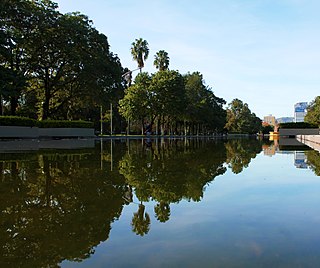
Porto Alegre is the capital and largest city of the Brazilian state of Rio Grande do Sul. Its population of 1,481,019 inhabitants (2016) makes it the twelfth most populous city in the country and the centre of Brazil's fifth largest metropolitan area, with 4,405,760 inhabitants (2010). The city is the southernmost capital city of a Brazilian state.

Rio Grande do Sul is a state in the southern region of Brazil. It is the fifth-most-populous state and the ninth largest by area. Located in the southernmost part of the country, Rio Grande do Sul is bordered clockwise by Santa Catarina to the north and northeast, the Atlantic Ocean to the east, the Uruguayan departments of Rocha, Treinta y Tres, Cerro Largo, Rivera and Artigas to the south and southwest, and the Argentine provinces of Corrientes and Misiones to the west and northwest. The capital and largest city is Porto Alegre. The state has the highest life expectancy in Brazil, and the crime rate is relatively low compared to Brazilian national average. Despite the high standard of living, unemployment is still high in the state, as of 2017.

The Ragamuffin War was a Republican uprising that began in southern Brazil, in the province of Rio Grande do Sul in 1835. The rebels, led by generals Bento Gonçalves da Silva and Antônio de Sousa Neto with the support of the Italian fighter Giuseppe Garibaldi, surrendered to imperial forces in 1845.

Bento Gonçalves is a municipality located in the state of Rio Grande do Sul, Brazil. Created in 1875, it is one of the centers of the Italian immigration in Brazil. It is also known as the 'wine capital of Brazil' due to its vineyards and wine production. In 2016, its estimated population was 114,203 inhabitants.

Guaíba is a city located in the Metropolitan Porto Alegre of Porto Alegre, in the Brazilian state of Rio Grande do Sul. The city is on the shores of the Guaíba Lake.

Santo Ângelo is a city located in northwestern Rio Grande do Sul state, Brazil. It has about 76,304 inhabitants and the total area of the municipality is about 677 km². It borders Giruá to the north, and Entre-Ijuís to the south—it's linked to Santo Ângelo by the state road RS 344. The city is located 443 km (275 mi) from the state capital, Porto Alegre.

Esteio is a municipality situated in the Brazilian state of Rio Grande do Sul, in the metropolitan region of Porto Alegre, the state capital. About 9.3 miles from Porto Alegre, and neighboring Canoas and Sapucaia do Sul, it has about 87,000 inhabitants.

Hubert Donat Alfred Agache was a French architect and urbanist known for his work in Brazil.

Viamão is a city in Rio Grande do Sul, Brazil. In size it is the largest municipality in the metropolitan region of Porto Alegre and the seventh most populous in the state.

Manuel Marques de Sousa, Count of Porto Alegre, nicknamed "the Gloved Centaur", was an army officer, politician, abolitionist and monarchist of the Empire of Brazil. Born into a wealthy family of military background, Manuel Marques de Sousa joined the Portuguese Army in Brazil in 1817 when he was little more than a child. His military initiation occurred in the conquest of the Banda Oriental, which was annexed and became the southernmost Brazilian province of Cisplatina in 1821. For most of the 1820s, he was embroiled in the Brazilian effort to keep Cisplatina as part of its territory: first during the struggle for Brazilian independence and then in the Cisplatine War. It would ultimately prove a futile attempt, as Cisplatina successfully separated from Brazil to become the independent nation of Uruguay in 1828.

The Economy of Porto Alegre is the fastest growing economy in Brazil and is currently the country's 7th largest regional economy. The city of Porto Alegre has a population of approximately 1.4 million people. The history of Porto Alegre, particularly during the industrial revolution established its economy and the basis of the current industrial sector in the city.

Cidade Baixa is a neighborhood of the city of Porto Alegre, the state capital of Rio Grande do Sul in Brazil.
Vicentino Prestes de Almeida, was a Brazilian paleontologist. He died on October 28, 1954, in São Pedro do Sul.

Três Figueiras is a neighbourhood of the city of Porto Alegre, the state capital of Rio Grande do Sul, Brazil. A residential neighbourhood, it embrace people from upper middle class to upper class, having many sophisticated houses. Três Figueiras was created by Law 2022 of December 7, 1959. There is located the Design School of Unisinos. Also, there has two highly regarded and traditional private schools, the Farroupilha and Anchieta schools, and a highly regarded private school for childhood, the Baby House.

Farroupilha is a neighbourhood (bairro) in the city of Porto Alegre, the state capital of Rio Grande do Sul, in Brazil. It was created by Law 2022 from December 7, 1959.

Farroupilha Park, also known as Parque da Redenção, is a major urban park in the city of Porto Alegre, the state capital of Rio Grande do Sul, in Brazil.
The Premiere is a Brazilian television channel on pay-per-view broadcasts the main football State Championships in Brazil, and the Brazilian Championship Série A and Série B. Globosat belongs to, and is present in SKY, NET, Claro TV and Vivo TV, and some operators outside the country, such as DirecTV and Dish Network. From 1997 to 2006 it was called Premiere Esportes, switching to Premiere Futebol Clube and then to PFC, but in 2011 moved again, this time to Premiere FC, which keeps the same name today.

Aldyr Garcia Schlee was a Brazilian writer, journalist, translator, illustrator and professor.

Events in the year 2003 in Brazil.
The following is a timeline of the history of the city of Porto Alegre, in the state of Rio Grande do Sul, Brazil.

















